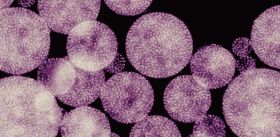NEWS RELEASE
5-APR-2024
Good as gold - improving infectious disease testing with gold nanoparticles
ADVANCED INSTITUTE FOR MATERIALS RESEARCH (AIMR), TOHOKU UNIVERSITY

IMAGE: GNDP particles
CREDIT: Hiroshi Yabu
By harnessing the power of composite polymer particles adorned with gold nanoparticles, a group of researchers have delivered a more accurate means of testing for infectious diseases.
Details of their research was published in the journal Langmuir.
The COVID-19 pandemic reinforced the need for fast and reliable infectious disease testing in large numbers. Most testing done today involves antigen-antibody reactions. Fluorescence, absorptions, or color particle probes are attached to antibodies. When the antibodies stick to the virus, these probes visualize the virus's presence. In particular, the use of color nanoparticles is renowned for its excellent visuality, along with its simplicity to implement, with little scientific equipment needed to perform lateral flow tests.
Gold color nanoparticles (AU-NP), with their high chemical stability and unique plasmon absorption, are widely employed as probes in immunoassay tests. They exhibit extreme versatility, with their colors fluctuating according to their size and shape. Additionally, their surface can be modified by using thiol compounds.
Conventional tests that use AU-NP often have to amplify AU-NP's optical density, so that scientists can easily measure the strength of the signal produced by the interaction between antibodies and the target substance.
Adding more gold nanoparticles is one means to do this. But because nanoparticles are tiny, it requires a large quantity of them to achieve a strong enough signal for accurate detection.
To overcome this, the researchers proposed a new method called self-organized precipitation (SORP). SORP works by dissolving polymers into organic solvents before adding a liquid that doesn't dissolve the polymers well, like water. After the original organic solvent is removed by evaporation, polymers assemble together, forming tiny particles.
"Using gold nanoparticle decorated polymers (GDNP) assembled by SORP, we set out to see how effective they would be in detecting the influenza virus, and whether they offered improved sensitivity in detecting antigen-antibody reactions," states Hiroshi Yabu, co-author of the paper and professor at Tohoku University's Advanced Institute for Materials Research (AIMR). "And it did. Our method resulted in a higher optical density than original AU-NPs and GNDPs decorated with smaller AU-NPs."
Yabu and his colleagues' findings reinforce that GNDP particles have broad utility, extending beyond laboratory settings to real-world diagnostic scenarios.
About the World Premier International Research Center Initiative (WPI)
The WPI program was launched in 2007 by Japan's Ministry of Education, Culture, Sports, Science and Technology (MEXT) to foster globally visible research centers boasting the highest standards and outstanding research environments. Numbering more than a dozen and operating at institutions throughout the country, these centers are given a high degree of autonomy, allowing them to engage in innovative modes of management and research. The program is administered by the Japan Society for the Promotion of Science (JSPS).
See the latest research news from the centers at the WPI News Portal: https://www.eurekalert.org/newsportal/WPI
Main WPI program site: www.jsps.go.jp/english/e-toplevel
Advanced Institute for Materials Research (AIMR), Tohoku University
Establish a World-Leading Research Center for Materials Science:
AIMR aims to contribute to society through its actions as a world-leading research center for materials science and push the boundaries of research frontiers. To this end, the institute gathers excellent researchers in the fields of physics, chemistry, materials science, engineering, and mathematics and provides a world-class research environment.
AIMR site: https://www.wpi-aimr.tohoku.ac.jp/en/
ARTICLE TITLE
Gold Nanoparticle-Decorated Polymer (GNDP) Particles for High-Optical-Density Immunoassay Probes
ARTICLE PUBLICATION DATE
30-Jan-2024
Media Contact
Public Relations
Tohoku University
public_relations@grp.tohoku.ac.jp
Source: https://www.eurekalert.org/news-releases/1040268#:~:text=Good
"Reproduced with permission - Tohoku University"
Tohoku University
For more HIV and AIDS News visit...
Positively Positive - Living with HIV/AIDS:
HIV/AIDS News |